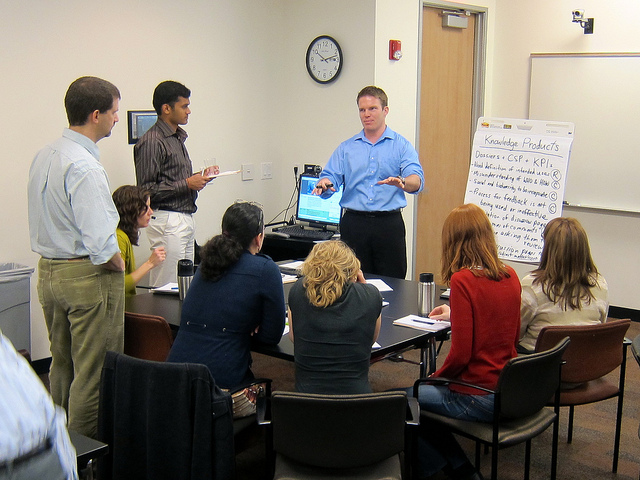
Conversational Intelligence at Work
Conversational Intelligence at Work https://csuiteold.c-suitenetwork.com/wp-content/uploads/2014/10/6861256042_0b37739bcd_z.jpg 640 480 C-Suite Network https://csuiteold.c-suitenetwork.com/wp-content/uploads/2014/10/6861256042_0b37739bcd_z.jpgby Judith Glaser
What if you could create an organization where change and transformation were exhilarating and natural? Where people were devoted, engaged and accountable to act as leaders rather than blind followers? Where people worked with each other to differentiate their brand and capture the hearts, minds and souls of customers?
At the Creating We Institute, we have spent the past 15 years studying how leaders are making the shift from top-down, control-driven styles of leadership to collaborative and engaging styles that activate growth in employees and attracts customers to partner for mutual success. What we’ve learned over the past decade and a half of research is profound. Some approaches lead to dramatic and exciting changes with long-lasting results, while others lead to short-term change without long-term impact. While many companies are now investing incredible time and resources into leadership and talent development programs — hoping to reap the benefits of a healthy, engaged and inspired workforce — our research has identified the key and vital characteristics for sustainable success.
While many companies focus on driving results as the primary factor for success, our research has uncovered one factor that eclipses results-driven leadership: the quality of the conversations that people use to drive success.
Conversations either open people up to experiment and try new things — all necessary characteristics for change and success — while others close people down or activate their fear of taking risks. When our fear networks are triggered during conversations, a neurotransmitter called cortisol is produced in high quantities, shutting down the part of our brain (the prefrontal cortex) where the capabilities for transformation and change reside.
Organizations and leaders that focus on mitigating the fear-response and activating the ability to take risks and work with higher levels of co-creation produce sustainable change and growth. To determine if your organizational conversations are opening up or closing down your organization’s success trajectory, consider the following conversations. Ask yourself: Am I creating a culture that enables colleagues to co-create the future? Do colleagues form feedback-rich relationships for mutual success, make their beliefs transparent and collaborate to co-create positive changes? Imagine that you have the power to activate Conversational Intelligence across your organization, one conversation at a time! What would that workplace look like?
Co-creating Conversations. Are conversations healthy?
Do people complain about others behind their backs, or do they have face-to-face discussions? Is there a lot of triangulation (people using others to tell someone what’s on their mind) or do people give direct feedback? Is there an ongoing conversation? Are people engaged in working out how to get to the end game, or are they distracted with conversations about why things are not moving forward? Is there a blaming/victim culture or an accountability culture? Is the enterprise being run by fear or hope? Do people share a common language and a common reality? Can people tell the truth?
Heart and soul. Is there a spirit of appreciation or a punitive spirit?
Do leaders complain about poor performance, or are they skilled at developing talent? Do leaders provide developmental feedback? Do they recognize good work and effort or only look for what’s wrong? Do they look at the past and complain about what’s not happening, or do they focus people on creating the desired future? Do they focus on problems or opportunities?
Actualizing of vision. Are leaders providing direction?
Often the vision is too far out for people to grasp the implications. When guiding principles are not practiced, breakdowns occur in the actualization of the vision and in relationships between leaders and employees in pursuit of achieving those visions. Leaders communicate a vision and expect employees to implement it. What’s missing is the interpretation of the vision down to the level of “what does it mean to me, and what do I have to change to get there?”
Networks. Are employees collaborating and bonding across boundaries?
Trust emerges when people support each other in the pursuit of their goals. Trust rituals either strengthen or weaken the culture. Some cultures form silos, where people are excluded from other divisions, departments or functions. Healthy organizations form networks that allow vital information, innovative ideas, and best practices to be shared internally and with outside vendors and customers. The mental health of the culture depends on the “wellness” of the tribes and sub-cultures co-creating together in spite of their differences. When teams are in conflict, there may be excessive gossip. The remedy is to bring the groups together to harmonize or expand their common perspectives.
Give and take. In what ways are colleagues engaging for mutual success?
An enterprise depends on the sharing of resources, ideas and practices to survive and thrive in the face of challenges. As colleagues learn to share and trust, leaders evolve the capability of sustaining trust in the face of challenges. Cultures that encourage brainstorming with no support process create frustration. Employees lose faith in their leaders and in themselves. A conversationally intelligent culture puts in place support systems such as Ideation and Innovation Labs. The management team resources projects designed to test and experiment with new ways of thinking and doing. People are rewarded for coming up with new products and services and turning their ideas into realities.
Enterprise mind. Is there a feeling that “we’re all in this together?”
Are employees and management linked as though they were “one mind”? Are people clear about who we are and what the company stands for? Are they learning from past mistakes to find new strategies? Are they doing this in collaborative teams, or are individuals seeking credit for themselves? Is there an enterprise brand? Do employees live the brand? Does the brand engage the hearts, minds and spirits of employees and customers?
Spirit. Is there a spirit of discovery and inquiry in the enterprise?
Are people learning from past mistakes and using them to work better? Can people let go of the past and embrace the new? Is everyone working to realize a common purpose? Are they developing leadership points of view? Are leaders pushing their ideas on others, or are they setting the stage for people to grow their points of view? What forums exist for pushing against the current rules and culture to create the next generation of thinking and being?
What kind of leader are you?
Unaware leaders blame others for what goes wrong. Self-aware leaders look inside and explore the impact they have on their culture. When you influence in positive and conversationally intelligence ways, you create a culture that sustains commitment and enthusiasm to achieve audacious goals, and great results follow.
 Judith E. Glaser is the CEO of Benchmark Communications, Inc. and the Chairman of The Creating WE Institute. She is the author of the best selling book, “Conversational Intelligence” (Bibliomotion, 2013), an Organizational Anthropologist and a consultant to Fortune 500 companies.Visit her at creatingwe.com; conversationalintelligence.com or contact her at jeglaser@creatingwe.com. Follow Judith on Twitter @CreatingWE.
Judith E. Glaser is the CEO of Benchmark Communications, Inc. and the Chairman of The Creating WE Institute. She is the author of the best selling book, “Conversational Intelligence” (Bibliomotion, 2013), an Organizational Anthropologist and a consultant to Fortune 500 companies.Visit her at creatingwe.com; conversationalintelligence.com or contact her at jeglaser@creatingwe.com. Follow Judith on Twitter @CreatingWE.




